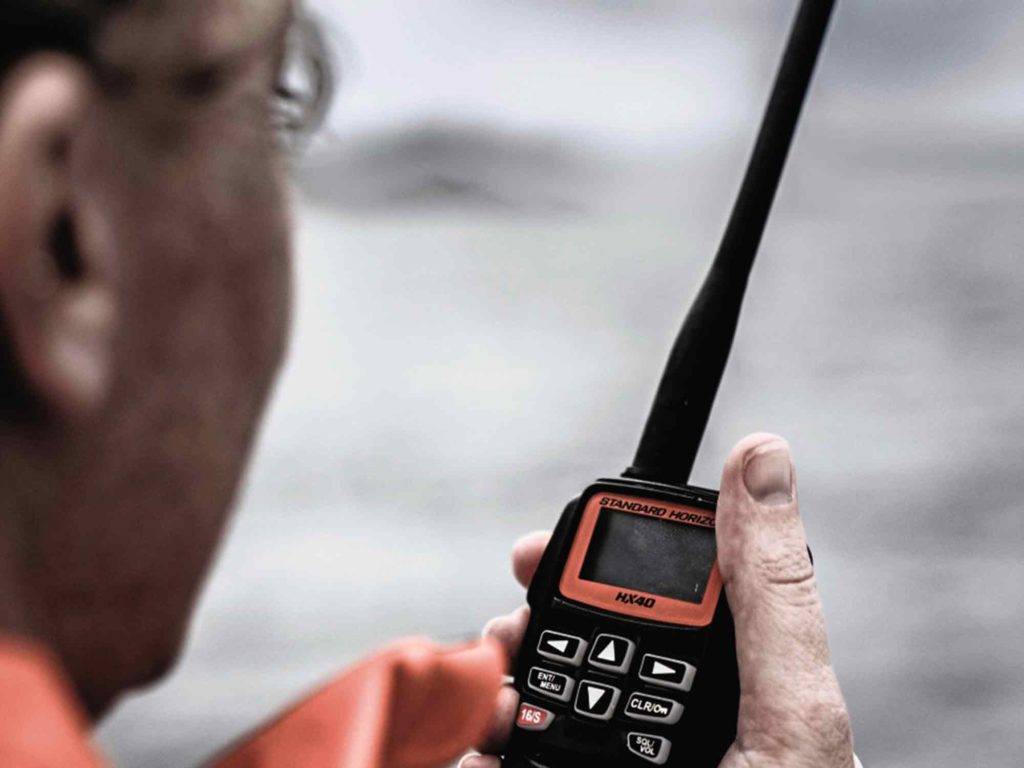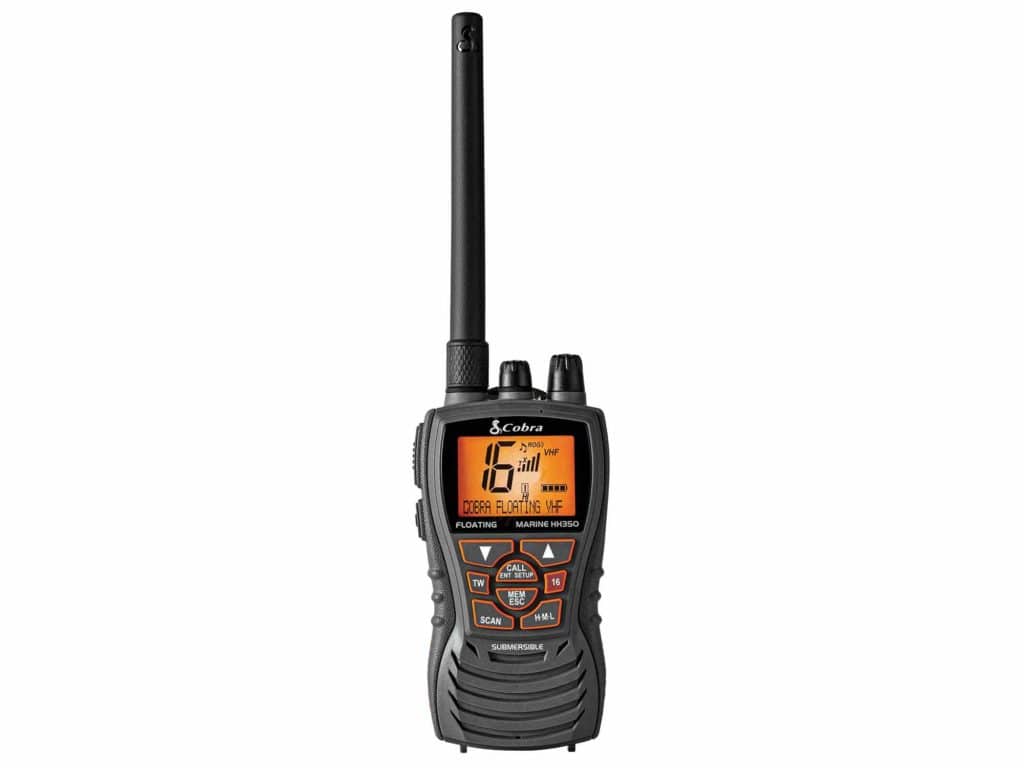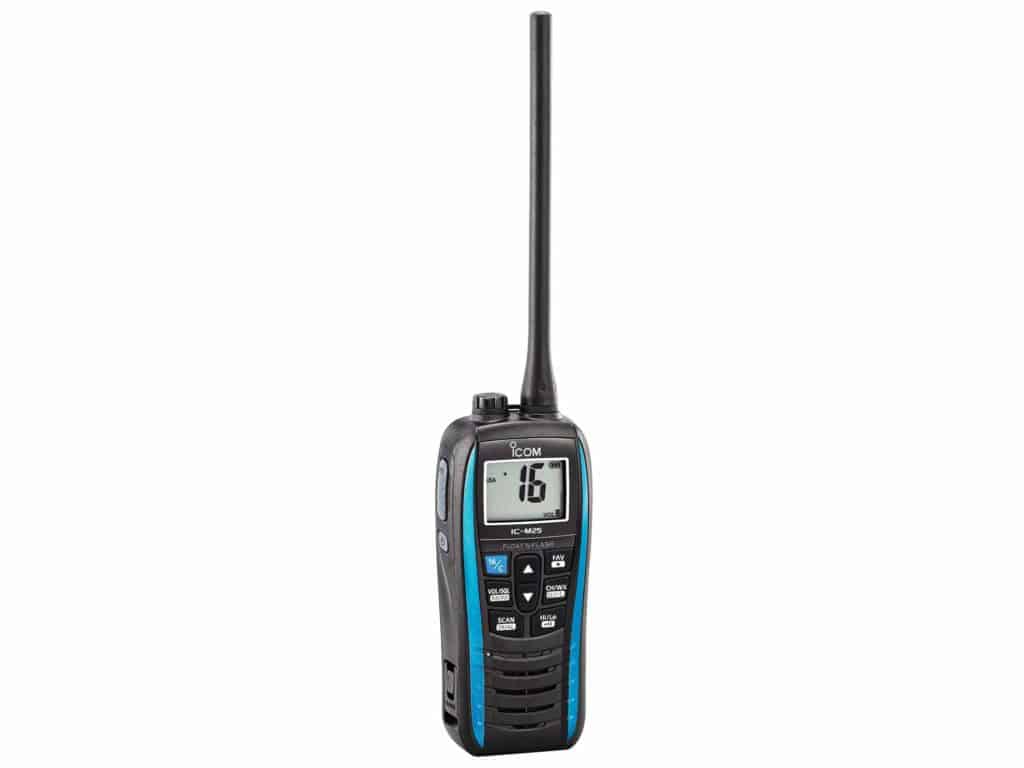
When it comes to ensuring on-the-water safety, few devices are worth their weight in as much fine Caribbean rum as a properly maintained and fully charged handheld VHF radio.
These typically waterproof radios are one of the most important tools available for contacting other vessels, getting weather information and—should calamity strike—contacting the US Coast Guard or other rescuing authorities. Their small size, relatively lightweight design, and rugged construction lets them slip into the pocket of a foul-weather jacket for a foggy night watch, or into a sea bag for a charter adventure. Most contemporary radios also have lanyards or belt clips, and an increasing number are buoyant.
All seven of the radios in this article float, and have a jack for an external speaker microphone, which can be handy at the helm.
As with all radio-communications equipment that’s legally sold in the United States, handheld VHF radios are tightly regulated by the Federal Communications Commission. Recreational marine-level handheld VHFs typically operate on more than 40 different channels, including dedicated channels for the Automatic Identification System, Digital Selective Calling and weather channels. These channels fall between 156.050 and 157.425 megahertz and 161.6 and 162.550 MHz, offer 1 to 6 watts of transmitting power, and deliver line-of-sight voice (and sometimes data) communications over ranges of about 3 to 5 nautical miles.
While all handheld VHFs must meet FCC criteria, they compete with one another on features such as display size and type, battery capacity, noise-canceling technologies, voice-scrambling capabilities, embedded GPS receivers, DSC functionality and, more recently, the listen-only AIS receivers.
Given that all radios make and receive voice communications, this article will consider the standout features of seven handheld VHFs from three manufacturers. As with many things electronics-related in 2022, not all brands or models were available for review.
Cobra HH350
Cobra’s HH350 provides significant communications bang for a minimal capital investment. It fits comfortably in hand, and its 10 user-interface buttons are positioned for one-handed operations (I’m right-handed, but this was easier with my left hand). The HH350 is waterproof to IPX7 standards, is buoyant, and has a strip of orange body plastic intended to make it easier to spot when it’s floating. It also sports Cobra’s Burp technology (if you press and hold the 16/9 and scan buttons, the radio emits a low-frequency tone that “shakes off” water from its speaker), which aids post-swimming performance. The radio’s backlit display makes it easy to read the screen in all light conditions, and users can transmit at 1, 3 or 6 watts of power, depending on the range. The HH350 has full access to all weather channels and alerts from the National Oceanic and Atmospheric Administration, and its noise-canceling microphone helps ensure that other parties can hear you in breezy conditions. The radio comes with a 1,000-milliampere-hour lithium-polymer battery, AC and DC charging options, a belt clip, a lanyard, and a charging station.
Cobra HH500

Given that Cobra’s HH350 and HH500 come in identically sized, IPX7-rated plastic cases, and that each displaces 0.58 pounds, it would be easy to confuse them as twins. This would be a mistake. While the two VHF radios share the same core features, the HH500 sports two extra user-interface buttons on its top row that yield additional capabilities. The appropriately colored Bluetooth button lets users pair the radio with a Bluetooth-enabled smartphone to use the radio’s microphone and speaker for making phone calls in rough weather. The HH500’s rewind say-again button allows users to record and replay the last 20 seconds of an incoming call, which is handy if there’s background noise from engines, flogging sails or wind. As with its little brother, the HH500 is ergonomically shaped for one-handed operations and has a dedicated tri-watch button that lets users simultaneously monitor three channels (Channel 16, plus two others). The WX button gives users access to 10 weather channels. The HH500 comes with a rechargeable 1,000 mAh lithium-polymer battery, a battery tray that accepts five AA batteries, and a backlit LCD screen.
Icom M25

When it comes to making voice calls without other onboard technologies competing for your attention, Icom’s M25 is a worthy contender. Its case felt comfortable in my hand, and its user interface was intuitive; I had no trouble accessing any of its 10 hard keys one-handed using either thumb. The M25 is built to IPX7 standards, and—like all Icom radios considered here—has Icom’s Float’n Flash technology, which triggers the radio to flash an otherwise-hidden LED when submerged (this clever feature works even if the radio is off). Users can clear water from the M25’s speaker by triggering a 10-second AquaQuake by simultaneously pressing the scan and high/low buttons. This causes the radio to emit a low-frequency water-shedding tone. The M25 can transmit at 1 or 5 watts, and it has an internal 1,500 mAh lithium-ion battery. There’s a dedicated Channel 16 button, it’s easy to jump from weather to communication channels, and the radio supports dual- or tri-channel scanning. Users can also set favorite channels. The backlit LCD screen is easy to read in varying light conditions, and the M25 is available in three trim colors.
Icom M37
This is a powerful, versatile and easy-to-use handheld, especially if you don’t mind a somewhat bulkier form compared with Icom’s M25. Like its little brother, the M37 has Icom’s Float’n Flash and AquaQuake technologies, however, it can transmit at 1 or 6 watts. The M37 also delivers 700 milliwatts of speaker output (the M25 yields 550 mW) and comes with a 2,350 mAh lithium-ion battery. Alternatively, the M37’s battery case can hold three AAA batteries (I’m a fan of this for ditch bags or extended excursions without the ability to recharge). The two radios have a similar user interface driven by 10 hard keys; both also employ one-button access to Channel 16 and the weather channels. While the M37 works fine, I found its size—compared with the M25—a bit cumbersome. One-handed operations were easier with my left paw, and while I could manage one-handed with my right hand, I often found myself defaulting to two-handed operations. Also, the M37’s price puts it in competition with other radios that are equally user-friendly but that also have DSC and GPS.
Icom M94D
Icom M94D AIS is the most important safety evolution to have hit marine communications in decades, and Icom’s M94D is the first handheld to bundle AIS, DSC, GPS and VHF in one package. While the M94D is the biggest and heaviest handheld in this article, it’s also the one that would be the most useful during a true emergency, given its ability to see—and directly hail—nearby vessels equipped with AIS transmitters. The radio comes with a 2,400 mAh lithium-ion battery, a 1,500 mW speaker, and the ability to transmit at 1 or 6 watts. The M94D is built to IPX7 standards, floats and flashes, and has Icom’s AquaQuake and noise-cancellation technologies. On the software side, the radio has a basic, waypoint-based navigation system, and it supports dual- or tri-channel scanning and four-digit VHF channels. The radio displays its latitude, longitude, day and time information; the vessel’s MMSI number; and the current channel number and name when operating in standard VHF mode. Should disaster strike, it’s easy to initiate a DSC distress alert via the user interface or by using the dedicated, flap-protected distress button on the radio’s backside.
Standard Horizon HX210
Standard Horizon’s HX210 might be the least-expensive radio discussed in this article, but it has significant radio-communications function in an IPX7-rated and buoyant form. The HX210 is built with a 15-button user interface (three keys are user-programmable) that can be operated using one or two hands (I found the former doable and the latter easier). Standout features include an embedded FM radio receiver (76 to 108 MHz), NOAA weather channels, a built-in and water-activated strobe light (you can select your preferred strobing pattern), and a dedicated Channel 16 button. The handheld radio can be set to monitor two or three channels simultaneously (read: Channel 16 plus one or two other user-selected channels). It comes with two scanning modes, and it has a generously sized (relative to the radio’s LOA and beam) high-resolution dot-matrix LCD screen that’s backlit and easily readable. Operators can transmit at 1, 2.5 or 6 watts, depending on their circumstances. The HX210 comes with a nonremovable 1,850 mAh lithium-ion battery that can be charged via AC or DC power using the included charging cradle; a battery indicator shows how much juice remains.
Standard Horizon HX890
There’s a lot to like about Standard Horizon’s HX890, from the way its IPX8-rated case fit my hand to its backlit, 1.7-by-1.7-inch dot-matrix display. Its user interface is intuitive and the most graphically based in this roundup, and I appreciate how it displays each channel’s numerical designation in big font with the channel’s nature in smaller type ( “16—distress,” “72—ship to ship”). The radio is DSC-enabled, and it’s easy to input and edit MMSI information. Thanks to the 66-channel WAAS GPS receiver, it’s also a cinch to see real-time latitude and longitude information, plus COG, SOG, day and time data while operating in VHF mode. DSC Call is the first item on the menu page, and there’s a flap-protected distress button on its backside that initiates a DSC distress alert. All told, the HX890 sports 17 hard-key buttons. The radio can broadcast at 1, 2 or 6 watts, and it has noise cancellation for receiving and transmitting. There are also two types of voice scrambling, and waypoint- and route-based navigation. It runs on a rechargeable 1,800 mAh lithium-ion battery (included) or five AAA batteries. Its strobe can be activated manually or automatically if submerged, and it has dual- and triple-channel scanning.
David Schmidt is CW’s electronics editor.
Just-In-Case Bags
If you’re buying a dedicated handheld VHF radio for your charter or ditch bag (smart!), here are a few considerations. For starters, it’s important to ensure that the radio’s internal battery is topped off before you head offshore or out on charter. If your radio can also be powered by removable batteries, it’s a wise idea to pack at least one or two spare rounds of DC juice (remember: AIS and GPS receivers require power). Also, while lightning strikes are thankfully rare, it’s a good idea to stow emergency electronics in a waterproof faraday bag. Finally, while modern handheld VHF radios are waterproof and typically buoyant, it’s still wise to pre-rig the radio with its lanyard. And, since we’re amassing an electromagnetically shielded worst-case-scenario bag, also be sure to include a 406 MHz PLB, AIS MOB and handheld GPS. —DS
VENDOR LIST
Cobra: from $120
Icom: from $130
Standard Horizon: from $100








